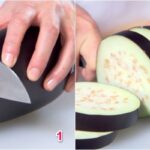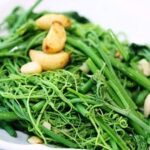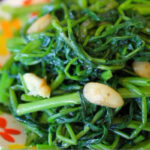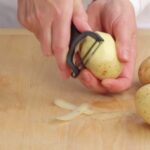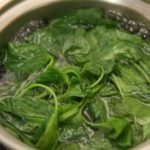In Vietnamese households, gas stoves are essential for cooking delicious meals. Some believe that using the right burner for stir-frying is better than the left. Is this belief true or false? Let’s find out!
1 Why is the right burner preferable for stir-frying?
It suits most people’s dominant hand
Since most people are right-handed, using the right-side burner can be more convenient for handling cooking utensils, stirring food, and seasoning dishes. Cooking on the burner that matches your dominant hand makes it easier to control your movements and reduces the risk of spilling food or causing burns.
 Match your stove usage with your dominant hand
Match your stove usage with your dominant hand
Reduced risk of burns
Using the left burner may cause you to accidentally bump into hot pots or pans as you move around the stove. This poses a burn hazard, especially for children. The right-side burner allows for easier movement and reduces the risk of accidents, ensuring safety during cooking.
 Reduced risk of burns
Reduced risk of burns
Stronger flame on the right burner
Many gas stoves are designed with a stronger flame on the right burner. Therefore, using the right burner for stir-frying can help food cook faster and more evenly, especially for dishes that require high temperatures. The left burner, with its smaller flame, is better suited for simmering, stewing, and boiling, which require lower heat and longer cooking times.
 Right burner typically has a stronger flame
Right burner typically has a stronger flame
2 Safety guidelines for using a gas stove
While a gas stove is a vital appliance in every kitchen, improper use can lead to potential hazards such as gas leaks, fires, and poisoning. Therefore, it’s crucial to follow these safety guidelines:
Ensure proper installation
-
Hire a professional to install your gas stove, ensuring it’s in a well-ventilated area, away from flammable materials, electrical sources, and with proper gas piping.
-
Place the stove at a comfortable height for cooking tasks.
-
Use high-quality gas control valves and hoses to prevent leaks.
 Proper gas stove installation is crucial
Proper gas stove installation is crucial
Regularly check for gas leaks
-
Inspect gas connections regularly by applying a diluted soap solution to the joints of the gas valve, hose, and cylinder. If bubbles appear, it indicates a leak, and you should shut off the gas supply and call for professional help immediately.
-
Consider using a gas leak detector for early warning.
 Regularly check for gas leaks
Regularly check for gas leaks
Practice safe cooking habits
-
When lighting the stove, always strike a match first, then turn on the gas.
-
Avoid using flammable objects to light the stove.
-
Never leave the stove unattended while cooking, and keep children away from the stove.
-
After cooking, turn off the stove and securely close the gas valve.
 Practice safe cooking habits
Practice safe cooking habits
Maintain and clean your gas stove regularly
-
Regularly clean the stove’s surface to remove grease buildup, ensuring efficient and safe operation.
-
Follow the manufacturer’s instructions for cleaning and maintaining the stove’s parts, including the burners, grates, and gas valves.
 Regular maintenance and cleaning are important
Regular maintenance and cleaning are important
Safely replace the gas cylinder
-
Always use cylinders from reputable sources to ensure quality.
-
Replace the cylinder when it’s empty or shows signs of damage.
-
Do not attempt to repair a cylinder yourself. Contact a professional for any issues.
 Safe gas cylinder replacement
Safe gas cylinder replacement
By following these safety guidelines, you can protect yourself and your family from potential hazards, ensuring your kitchen remains a safe and cozy space.
Using the right burner for stir-frying offers advantages in terms of convenience, safety, and better-cooked food. However, it’s important to use both burners flexibly, depending on the type of dish you’re preparing and your personal cooking preferences.
The Ultimate Guide to Eggplant Preparation: A Chef’s Secrets Unveiled
The aubergine, or eggplant, is a versatile vegetable with a unique taste and texture. This article will reveal tips and tricks to prepare and cook aubergine to perfection, enhancing its natural sweetness and reducing any bitterness. Discover the secrets to unlocking the full potential of this nutritious vegetable with our expert guide.
“Should You Boil or Stir-Fry Your Veggies? 5 Veggies You Should Never Boil and Why”
“Are you aware of the nutritional differences between stir-frying and boiling your vegetables? It’s time to uncover the truth and discover which cooking method retains the most nutrients. This article will delve into the science behind these two popular cooking techniques and provide insights into how you can maximize the nutritional value of your meals. It’s an eye-opening exploration that will change the way you cook forever.”
The Ultimate Guide to Potato Preparation: A Simple and Effective Approach
“Uncover the secrets to preparing potatoes like a pro. Learn the art of swiftly peeling potatoes with precision, enhancing the flavor of boiled potatoes, and mastering the technique of stir-frying potatoes without ending up with a mushy mess. We’ll also reveal how to eliminate the odor of frozen potatoes and maintain the deliciousness of white potatoes. Get ready to elevate your potato game!”
“The Ultimate Guide to Stir-Frying Vegetables: A Colorful and Delicious Feast”
Are you tired of overcooked, bland, and unappealing stir-fried vegetables? It’s time to elevate your vegetable game! With our expert tips and tricks, you can master the art of stir-frying and create dishes that are not only delicious but also visually appealing. Imagine serving up a plate of vibrant, perfectly cooked vegetables that will have your family and friends asking for seconds. Learn from us, and your stir-fried vegetables will always be the star of the meal!

























